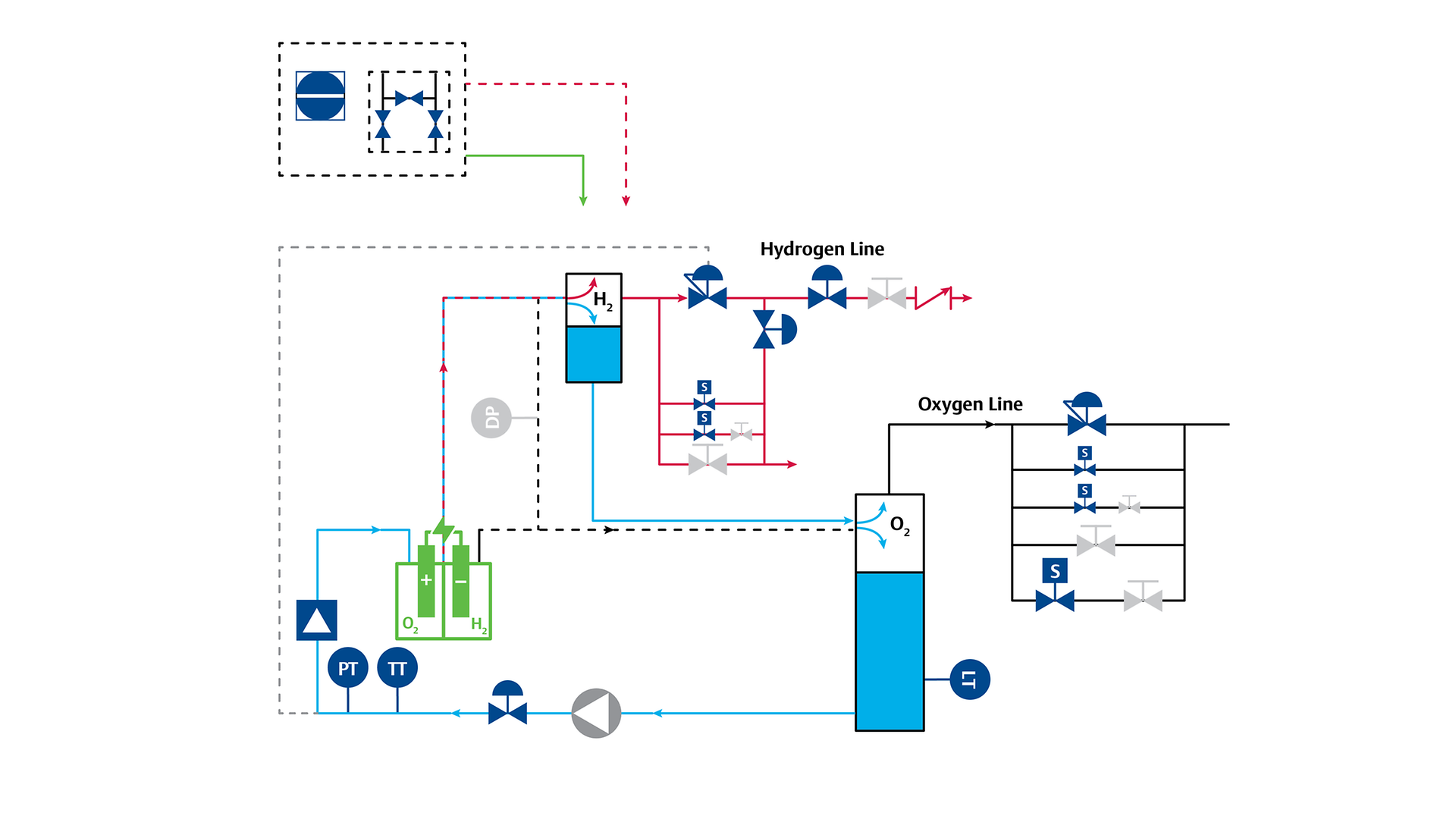Accelerating the Transition to a Hydrogen Future
Emerson delivers environmentally sustainable solutions for customers across the hydrogen value chain.

Hydrogen electrolyzer production requires scalable designs and capacity to respond to market demand. Manufacturers must execute projects on-time, on-budget with low complexity. Yet, operate safely, reliably, and profitably using the most advanced technologies.
Edge Controls RX3i
Scalable, open, and interoperable high-speed deterministic controls for your most demanding applications.
Fisher GX, easy-e, and HP Control Valves
Fisher globe valves offer broad process versatility, solve your application needs from big to small, hot to cold, general to severe.
Rosemount 3051 Series Pressure Transmitter
Pressure measurement products provide the broadest offering available to meet virtually every application need.
ASCO 290 Angle-Body Piston Valve
The ASCO Series 290, also known as 8290, is a pressure-operated, direct acting angle-body piston solenoid valve built for demanding applications.
TESCOM Back-Pressure Regulators
Highly accurate, high-flow, low-pressure backpressure regulators for use in pressure control of electrolysis cell and pump discharge pressure control.
Aventics Valve Island
The AVENTICS Series provides a reliable basis for both compact handling systems and complex automation solutions.
Rosemount™ X-well™ Technology with Rosemount 3144P Temperature Transmitter
Rosemount X-well Technology accurately measures internal process temperature without a thermowell or process penetration.

Hydrogen production requires scalable designs and capacity to respond to market demand. Implementing the right automation technologies to a large electrolyzer plant can help to ensure efficient architecture design, reduced safety risk, reduced cost, and optimized implementation to deliver optimal total cost of ownership.
Fisher GX, easy-e, and HP Control Valves
Fisher globe valves offer broad process versatility, solve your application needs from big to small, hot to cold, general to severe.
On/Off Isolation Valves
Emerson has an extensive isolation valve portfolio to help you safely and effectually control many different types of processes.
Rosemount X-Stream Gas Analyzer
Precision analysis of multi-components in process applications down to ultra low ppm.
Gas Leak Detection
Ultrasonic gas detectors use acoustic sensors to “hear” leaks, triggering an early warning system.
Creatively and strategically leverage solutions and expertise to integrate a cleaner energy mix.

Emerson’s leading measurement, control and electrical technologies, global network of application experts, and engineering solution services make the company the ideal partner in this emerging technology.

Emerson is an expert solution partner with the flexibility to meet a wide variety of demanding applications, from electrolyzers to hydrogen refueling stations to fuel cells.

Emerson technologies, including Digital Twin, control and monitoring systems and Plantweb Optics Platform, position Emerson as the perfect partner for hydrogen-based solutions that can help companies adopt and implement hydrogen solutions at scale.

Emerson’s ability to provide technology, engineering and deep expertise across the hydrogen value supply chain, accelerates the development of hydrogen as a viable energy source.
Frequently Asked Questions about Renewable Hydrogen
Simply put, green hydrogen is renewable hydrogen. The color refers to the different raw energy sources used to produce the hydrogen, which today are almost exclusively coal and natural gas due to their abundance and low cost. The production of this fossil fuel-based “grey” hydrogen from steam methane reforming or gasification always generates a positive net level of CO2 emissions, even when carbon capture technology is used downstream to make cleaner “blue” hydrogen.
Renewable (green) hydrogen earns its name by using an entirely different production method, electrolysis, which can be powered by electricity from carbon-neutral or renewable energy sources, such as wind, solar and biomass, with only oxygen as a byproduct. With the development of increasingly efficient electrolysis and fuel cell technologies, green hydrogen could supplement and eventually replace natural gas, petrol, diesel and other fossil-based fuels across the global economy in the next 20 years.
Electrolysis is an electrochemical process by which an electrical current is applied to water, splitting the hydrogen and oxygen atoms in the molecules and releasing them as pure gases. Hydrogen is collected and transported or stored for later use as a fuel or raw material. The necessary electrical current can be pulled from the existing power grid or from renewable energy sources, as is the case with green hydrogen.
The issue facing engineers today is two-fold: scaling up electrolysis technology so that the capacity per unit is high enough to meet growing regional, and eventually global, demand; and making them more efficient so that they consume less power and operational resources to generate the same amount of H2 gas of the necessary purity. Further investment in research and development to solve these problems is needed before the global economy can fully benefit from the commercialization of green hydrogen as a fuel.
Automation technologies increase the capacity, reliability and efficiency of electrolyzers -- and with them the potential of a green hydrogen economy -- in several ways, from handling fluctuating power loads to measuring and controlling water flow with greater precision to using digital analytics for energy management applications. Automation can also improve safety, equipment lifespan and regulatory compliance while lowering materials and workforce costs.
Another critical step in reaping the benefits of a green hydrogen-powered energy market is developing fuel cells that are small and lightweight but also durable and dependable enough for transportation applications that require high power-density systems. Because they are rated to operate in extreme temperatures and very high pressures, advanced digital solutions -- namely automated pressure regulators, flow sensors and solenoid valves -- make it possible to build and use the kind of cost-effective fuel cells that offer the reliability in a compact footprint that the industry needs to get moving.
Nicolas Marti, business development manager in alternative fuel and combustion at Emerson, explains how the success of the green hydrogen industry depends on reliable production, storage, transportation and process across the supply chain.
Get your Accelerating the Transition to Hydrogen Fuel e-book detailing the solutions to key challenges OEM's face in hydrogen processes. In this e-book, you will learn about:
Complete the form to access your complimentary copy of our Accelerating the Transition to Hydrogen Fuel e-book today.